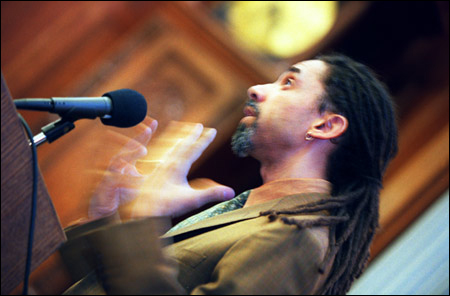Syncretic miracles
Free trade among U.S., Africa, Middle East is music to the ears

In the 1920s, a young bandleader named Duke Ellington galvanized audiences at Harlem’s Cotton Club with infectiously rhythmic dance tunes that came to be known as “jungle music” because of their supposed resemblance to the music of Africa.
Thirty years later, another jazz pianist named Randy Weston also tapped into African music for inspiration, but did so with an authenticity and seriousness of purpose that those early Cotton Club patrons probably would have found perplexing.
Jazz had come a long way in 30 years. Musicians of the late 1950s and early ’60s were responding to a very different world marked by the civil rights struggle, the growth of the Black Muslims, the end of colonial rule in Africa, and the rise of pan-Arabism under leaders like Egyptian President Gamal Abdel Nasser.
On Nov. 18, social historian Robin D.G. Kelley gave the first of three lectures on this politically and musically exciting period and the interactions between American and African musicians that gave birth to a new musical synthesis. Kelley’s talks are being presented as the Nathan I. Huggins Lecture Series, sponsored by the W.E.B. Du Bois Institute for African and African American Research, the Department of African and African American Studies, the Department of History of American Civilization, and Harvard University Press.
Kelley, a professor of African American studies and anthropology at Columbia University, narrowed his focus to two musicians, Weston and the multi-instrumentalist Ahmed Abdul-Malik. Both artists were born and grew up in the Bedford-Stuyvesant section of Brooklyn, a center of African musical and cultural influences in the 1950s and ’60s.
Among these African-oriented institutions, Kelley mentioned the African Quarter, a Brooklyn restaurant where many musicians and political activists congregated; the numerous associations active at the time that solicited support for developing African nations; and the United Nations Jazz Society, which organized concerts and lectures and brought jazz musicians together with international diplomats.
It was in this atmosphere that Weston issued his album, “Uhuru Africa,” using the Swahili word for freedom. It featured performances by many of the most prominent avant-garde jazz musicians of the day, plus lyrics by poet Langston Hughes celebrating the rebirth of African freedom.
Weston first visited Africa in 1961, discovering the vibrant jazz scene in Nigeria and other countries. Nigerians had already assimilated the music of American big bands like the Glenn Miller Orchestra and were beginning to experiment with modern jazz. This music was overshadowed, however, by a popular dance music known as High Life, which Weston brought back to America and combined with the harmonic influence of Thelonious Monk.
Meanwhile, Weston’s contemporary, Ahmed Abdul-Malik, played with both American and Middle Eastern musicians, demonstrating a strong interest in the music of Islamic cultures. Malik made his first recordings as a leader in 1958, playing music based on Arabic scales. The following year he recorded an album for RCA Victor called “East Meets West,” which the record company marketed to cash in on a craze for Middle Eastern music.
Many recordings of Middle Eastern music of this time featured garish album covers showing stereotyped scenes of Arab life and liner notes that catered to Western fantasies of the exotic and sensuous East. But, Malik, who was a devout Muslim, had aspirations that were far more spiritual and aesthetic than commercial.
“I think it’s reasonable to assume that part of Malik’s agenda was to restore respectability and spirituality back to this music,” Kelley said.
Like Weston, Malik made several visits to Africa, bringing back musical ideas that he assimilated into his own performances. While much of his music was syncretic, fusing Arabic scales and rhythms with those of jazz and blues, the African influence was by no means superficial. Kelley said he hoped to refute a claim often made by jazz critics, that American musicians in the 1950s and ’60s were largely responding to an imagined Africa.
“For these two gentlemen, Africa was hardly imagined. It was right outside their door.”




